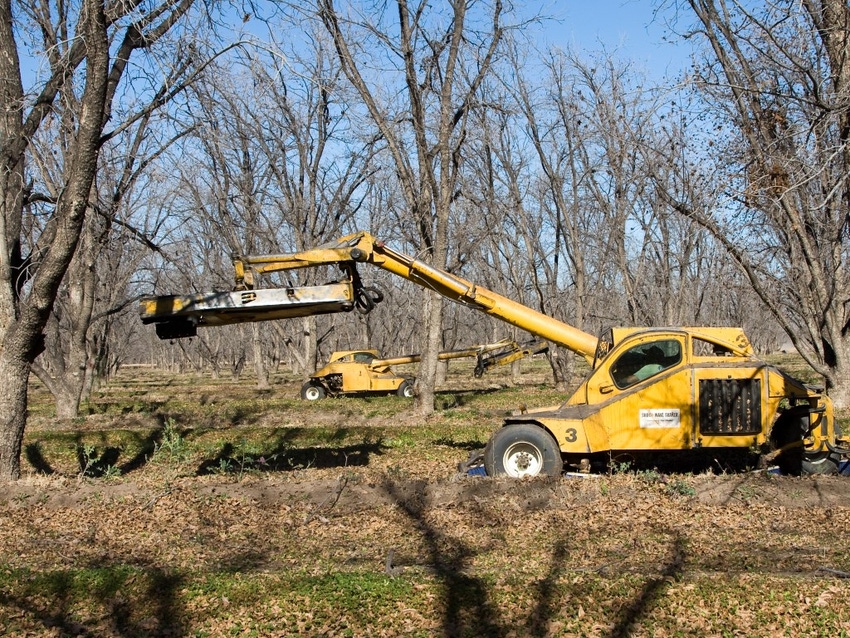
Success at Green Valley Pecan Company family rooted
“No one grows a better pecan,” says Rich Walden, farm manager with the Green Valley Pecan Company in Southern Arizona.He credits family efforts and fertile growing conditions in the Southwest for producing sweet and nutritious nuts.
April 24, 2015

Farming a crop is one thing. Producing a product which makes a grower proud takes the challenge to the next level, says Arizona pecan grower Rich Walden.
“No one grows a better pecan,” says Walden, farm manager with the Green Valley Pecan Company (GVPC) in Sahuarita, located in Southern Arizona about 50 miles north of the U.S.-Mexico border.
He credits family efforts and fertile growing conditions in the Southwest for producing sweet and nutritious nuts.
GVPC is one of the world’s largest pecan growers and processors. The Walden's are one of two growers who shepherd pecan crops from the 'blossom to the package.'
The Sahuarita farm includes the largest irrigated pecan orchard in the world.
“Due to our uncompromising commitment to quality, we are the largest pecan exporter to Europe and the largest supplier of organic pecans in the U.S.,” Walden said.
Pecan the best fit
Rich’s father - Dick Walden - says the family manages all aspects of pecan production. Dick’s father Keith Walden founded Farmers Investment Company (FICO) in the mid 1940’s and grew cotton.
He also lined the banks of the Santa Cruz River in Sahuarita with various types of nut trees, including 100-foot-long test rows of pecans, pistachios, walnuts, filberts, and almonds. The senior Walden also experimented with different types of fruit.
A decade later, he decided the best chance for success was pecans or wine grapes. Since grapes were more perishable and required hand labor to harvest, he opted to grow pecans – the hardier crop which could be mechanically harvested.
The first pecan trees – the Western Schley and Wichita varieties – were planted and still bear fruit with steady yields.
The Walden family owns FICO which owns GVPC.
Three-farm operation
GVPC maintains trees in three orchard areas covering about 8,300 acres: the 12-mile-long, 7,000-acre Sahuarita property south of Tucson; an operation in southeastern Arizona's Cochise County; plus a farm in Georgia.
“We maintain a quarter of a million trees (total),” says Bruce Caris, GVPC’s vice-president and chief operating officer.
On the Sahuarita farm, almost 90,000 trees stand tall with another 30,000 small trees in the nursery. The Cochise County operation at San Simon near the Arizona-New Mexico state line includes about 3,000 acres of trees – about 50 trees per acre.
The Georgia operation includes about 16,000 trees on more than 800 acres.
“The total farm acreage makes us the largest in the world,” said Caris.
GVPC provides about 10 percent of all pecan processing in the U.S., making the operation one of the nation’s top five processors.
Summer chores
Summertime in Arizona pecan orchards includes pruning, irrigation, and mowing, plus applications of compost rather than nitrogen, plus zinc sprays to increase yields.
Production varies year-to-year with a 10 percent to 30 percent yield swing as pecans are an alternate-bearing crop. This year, the Walden family expects to produce about 8 million pecan pounds on the Sahuarita farm.
Trees about 20-feet tall on the San Simon operation were planted in 2006 and should reach commercial production in the next several years.
During a tour of the Sahuarita operation, Rich Walden discussed the nut-growing season which begins in March and April. Typical bud break is in late-April to early May.
By October, the hard shell is in place and cooler temperatures help the outer covering dry up and the nut develop.
Pruning creates better crop
Three pruners with 36-inch blades trim the trees on the Sahuarita farm. While there is discussion across the pecan industry on whether or not to prune pecan trees, Walden says pruning makes a positive difference allowing some sunlight into the canopy.
The trees are pruned about every 3-4 years.
Walden reflected, “As a kid, I remember walking through these fields and the grove floor was as dark as a jungle since there was no sunlight. Today, pruning may mean contending with weeds but we’re getting better crops overall.”
Today, 17 acres are dedicated to creating compost from tree byproducts.
“Until a few years ago, we fertilized our fields with manure until fellow farm manager Allan Brandt suggested grinding up the plant trash from harvest - tree branches, empty pecan shells, and leaves - into wood chips and shavings, to plow into the fields.”
Trend toward organic
The GVPC growers are responding to marketplace demands. Two-thirds of the pecan trees are grown conventionally and one-third is organic.
“Organic is a big commitment, but you get a better premium,” Walden explained. “Compared to the disease and pest issues which can occur in fields in the East, we’re one of the few places where organic pest control works due to our regional climate.”
He added, “We have really good drainage here. “When it rains down near the (U.S.-Mexico) border or on either side of our mountain range by us the water drains our way.”
Walden estimates 30 percent of rain passes by the tree roots into the aquifer.”
Stewardship critical
The Walden family embraces the stewardship of the land. The San Simon farm uses 100 percent sprinkler irrigation. Micro-sprinkler systems are being added to the Sahuarita grove to minimize evaporation and reduce the water footprint.
Expansion of the Sahuarita farm is unlikely due to growing urban development from nearby Tucson. Future expansion could be in eastern Arizona or western New Mexico.
Today, pecan prices continue to rise. Arizona is the fourth largest pecan-producing state in the nation - on track to increase production to about 40 million pounds in the next decade.
You May Also Like



